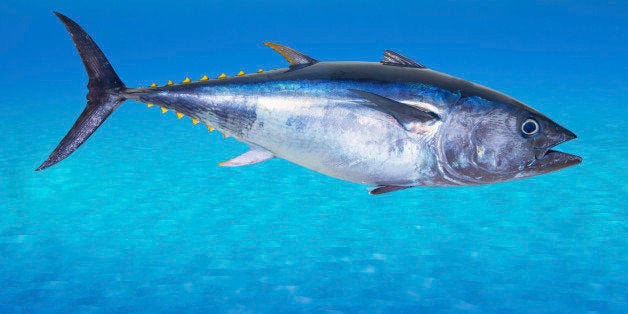
In the late '80s, when Earth Island Institute started the campaign to end the deaths of dolphins in tuna nets, about 80,000 to 100,000 dolphins were being killed each year. In 2012, the official count, based on international observers onboard tuna vessels, was 880 dolphins.
Time magazine called our Dolphin Safe campaign one of the most important successes of the environmental movement that decade.
In the Eastern Tropical Pacific (ETP), an area that roughly lies from the southern coast of California to the northern coast of Peru, and out almost to Hawaii, yellowfin tuna often swim beneath pods of dolphins. In the late 1950's, fishermen began targeting the dolphins with spotter helicopters and airplanes, and chasing them down with speedboats. Once exhausted, the speedboats keep the dolphins in a tight circle while the mother-ship comes up to deploy a purse seine net that is almost a mile long.
Despite efforts in the 1970's to release as many dolphins as possible, purse seine netting still killed thousands of dolphins. An estimated 7 million dolphins or more have been killed in tuna purse seine nets in the ETP.
Our Earth Island Dolphin Safe Campaign established the standards for Dolphin Safe tuna: No chasing or netting of dolphins, in order to prevent any harm to dolphins. Those standards have been voluntarily adopted by more than 90 percent of the world's tuna industry (companies in Mexico, Colombia and Venezuela are the main holdouts). Congress in 1990 enacted the Dolphin Information Consumer Protection Act that established these same standards in law for Dolphin Safe tuna in the US. All tuna bearing a Dolphin Safe label in the US must meet these catch standards.
There have been frequent attacks on the Dolphin Safe tuna label, notably by the Mexican government and a handful of tuna millionaires in Mexico. Earth Island has successfully opposed these attempts in Congress and in the US courts. Mexico claims they protect dolphins by releasing them after they catch the tuna, but peer-reviewed scientific research by the US National Marine Fisheries Service has demonstrated that dolphin populations are still suppressed by the practice. One major concern is that baby dolphins cannot keep up with their mothers during the chase phase of the tuna operations; they fall behind and starve or are eaten by sharks. Mexican tuna is NOT Dolphin Safe. The brands Dolores Tuna and TUNY Tuna show up in some US supermarkets, and Earth Island works to alert these markets that the tuna they are selling kills dolphins.
Earth Island established our International Monitoring Program in 1991 to verify that tuna was Dolphin Safe in accordance with our standards. We worked for many years lining up tuna companies around the world to sign a Dolphin Safe policy with Earth Island, which allows access by Earth Island tuna monitors to the companies' vessels, processing plants, and storage facilities. Monitors also review catch records provided by the companies on a regular basis, as well as conducting onsite inspections. International monitors (not affiliated with Earth Island, but appointed by governments) are now onboard virtually all Pacific Ocean tuna purse seine vessels. Our monitors also investigate any reports of nonconformance by tuna companies to our Dolphin Safe standards and require the tuna involved to be taken off the market. In 2013 alone, Earth Island tuna monitors conducted 768 inspections of tuna operations in 70 countries around the world.
The Mexican government, on behalf of their tuna industry, have gone to the World Trade Organization (WTO) complaining that the Dolphin Safe rules discriminate against them - the WTO issued a decision backing Mexico, but the US government changed the rules so they applied to all tuna companies beyond just the ETP, effectively keeping the strong no-encirclement standards for Dolphin Safe tuna in US law while avoiding discrimination against Mexico. The issue is now back in the WTO, and we expect a new ruling shortly as to whether the new US rules satisfy the WTO.
Some contend that catching tuna without dolphins harms the environment because of bycatch of other species in the tuna nets. These alarmist claims are exaggerated.
Earth Island is working with other organizations to improve tuna fishing both to continue to protect dolphins and to reduce bycatch. One method of fishing uses Fish Aggregating Devises (FADs) that are basically floating rafts that attract and concentrate tuna and other fish. We have worked to improve the management of FADs by fishing companies and setting rules to reduce bycatch, such as provisions requiring release of sea turtles and sharks alive from tuna nets.
We have also pioneered efforts with Safeway and other brands to produce FAD-free tuna that features tuna caught by hook & line or by purse seine nets set on free schools of tuna, methods which have minimal bycatch.
Dolphin Safe tuna is the best tuna to buy. The main species in canned tuna is the Skipjack tuna, a species that is short lived and renews itself rapidly, unlike the yellowfin tuna stocks which are showing signs of overfishing in the ETP related to the dolphin-deadly fishing practices of Mexico and other countries. Skipjack stocks, unlike other tuna stocks, are healthy at present throughout the world oceans. Furthermore, skipjack do not associate with dolphins.
Not all countries have laws that require "truth in advertising," so one must be careful about claims of "Dolphin Safe" or "Dolphin Friendly" tuna in foreign markets. Mexico, for example, allows tuna caught by killing dolphins to be labeled "Amigo del Delfin." The best source of information on companies that are truly Dolphin Safe is on our website .
Earth Island's International Monitoring Program for Dolphin Safe tuna continues to verify that catching tuna does not harm dolphins, reduce bycatch of other non-target species, and improve the fisheries.
For further information on Dolphin Safe tuna, a list of the companies that maintain Dolphin Safe policies, Alerts about dolphin-deadly tuna, and our program's Annual Reports, go to our website.